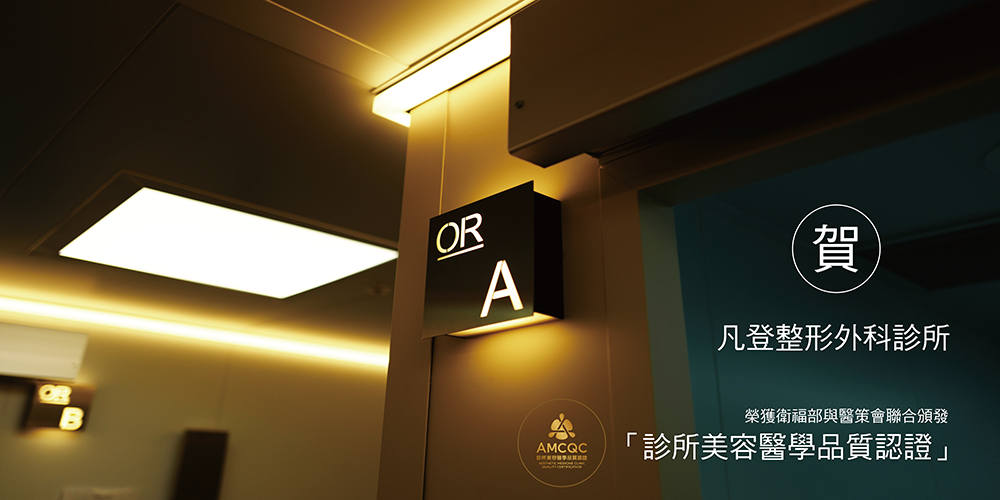Orthognathic Surgery


Hugo L. Obwegeser

Dr. Hugo L. Obswegeser, the father of modern orthognathic surgery once said “Few procedures can alter the human face so fundamentally as orthognathic surgery”, and that is also the reason for me to to dedicate my speciality to orthognathic surgery.
Dr. Obwegeser completed his first case of orthognathic surgery in the 1950s when anesthesia methods were not advanced. The patient bled tremendously and was hospitalized for a month. Dr. Obwegeser did what every doctor would do: he prayed. He prayed to God for the full recovery of his patient and and promised to quit performing such surgery if his patient can fully recovered. A month later, the patient was discharged with surprisingly satisfying outcome. However, Dr. Obswegeser “fasutian his bargain, trade with the devil” and continued his work in orthognathic surgery until the procedure has been brought to common practices.
I was honored to attend Dr. Obwegeser’s talk at the annual meeting of the American college of oral and maxillofacial surgeons in 2011. After Dr. Obwegeser’s retirement, his nephew Dr. Joachim A. Obwegeser continued his great work and taken over his position at the Maxillofacial surgery center in Zurich, Switzerland.
What is Orthognathic Surgery?
Orthognathic surgery is a procedure performed by cutting and realigning the upper and lower jaw with the purpose to correct skeletal and dental irregularities, improving facial contour and enhance aesthetic appearance.
Orthognathic surgery can improve occlusion, eating, and sleeping by correcting deformities such as protruding chin, overbite (maxillary protrusion), preceding lower jaw, and unbalanced facial appearance.
Common Facial Structure For Orthognathic Surgery

Unbalanced, Asymmetrical Facial Appearance

Receding Lower Jaw
(Weak Chin)

Protruding Lower Jaw
(Long Chin)

Protruding Upper Jaw
(Overbite)
Common Surgical Techniques For Orthognathic Surgery
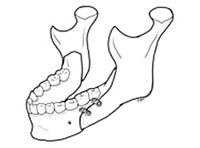
Bilateral Sagittal Split Osteotomy
(BSSO)
The lower jawbone is carefully cut on both sides after the incisions are made below the teeth to expose the jaw. The jawbone is then moved forward or backward to the ideal position and secured with plates and screws.
The procedure adjusts and improves the facial contour of the lower face.
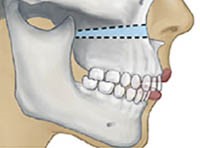
Le Fort I OSTEOTOMY
Incisions are made above the teeth to expose the upper jaw. The bone of the upper jaw is then repositioned, and a part of the jawbone is removed. Upper jaw is then secured with plates and screws.
The procedure adjusts and improves the facial contour of the mid face.
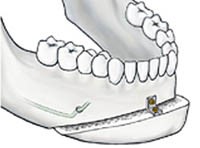
GENIOPLASTY
Sliding genioplasty: incision is made behind the lower lip where the chin bone is cut and moved forward to the ideal position before securing the bone with wire or screws.
Chin implants: silicone implant is inserted into the chin through a small incision to lengthen chin and to enhance the facial profile.
Pre-Operative Assessment for Orthognathic Surgery
In prior to your orthognathic surery, photographs (extraoral frontal, profile, 3/4 view), radiographs (intraoral maxillary occlusal, mandibular occlusal photographs), panoramic and cephalometric projection x-rays, and intraoral x-rays, and mouth molds are taken for a detailed surgical plan. Hematological test is also required after the confirmation of your surgery date.
Orthognathic Surgery - Anesthesia and Safety

Orthognathic surgery with general anesthesia is a well-established and safe procedure with limited chance of hemorrhage and anesthesia complications. However, every procedure requiring anesthesia has its own risk related to the to the patients’ health condition and the anesthesiologist in charge.
At Vendome Aesthetic Medical Center, board-certified anesthesiologist and certified registered nurse anesthetists are present at all times: before, during, and after your orthognathic surgery.
In prior to the surgery, anesthesiologists or nurse anesthetists will examine your health condition, and take note of your medical, drug, and anesthesia history before anesthetics administration. During the surgery, anesthesiologist will be in charge of the anesthesia devices, intravenous fluids and monitor your vital signs.
It is necessary to avoid food and beverages intake for 8 hours prior to your scheduled orthognathic surgery to prevent risks of vomit and choking.
Professional Orthognathic Surgery Team
At Vendome Aesthetic Medical Center, an inclusive case manager is assigned to each patient from the first orthognathic surgery consultation to the braces removal. Your case manager will provide assistance on making appointments, in charge of booking your routine check-ups, followups throughout before, during and after the patients’ recovery.
Inclusive Team of Board-Certified Anesthesiologists
Stardust Anesthesia and Sedation Specialists has partnered with Vendome Aesthetic Medical Center to provide anesthesia services. Board-certified anesthesiologist and certified nurse anesthetists are present throughout your treatment for pre-operative evaluation, physiological examination, orthognathic surgery, and post-operative nausea, vomiting, and pain management. Dr. Bai Chuan Su, founder of Stardust Anesthesia and Sedation Specialists shared his thought on the importance of anesthesia of orthognathic surgery:
1. Potential Airway Obstruction
Extra caution are required for patients with micrognathia and hemifacial microsomia undergoing general anesthesia as airway obstruction may occur.
Vendome Aesthetic Medical Center is fully equipped with specialized airway devices including Difficult Airway Trolley (DAT), Laryngeal Mask Airway (LMA), Trachlight intubation, and hospital standard bronchoscopy.
Also, specialized anesthesia induction routine are performed for patients with potential airway obstruction. Suggamadex, a revolutionary drug for effective reverse neuromuscular block reversal within 3 minutes is also in stock.
2. Hypotensive Anesthesia
In addition to instant arterial blood pressure monitoring, local anesthetics are used for complete neuromuscular blockade to prevent the usage of antihypertensive medication.
97% of patients does not required intravenous hypertensive medication to undergo hypotensive anesthesia as specialized blood pressure control technique is utilized during surgery. Therefore, complications caused by the medications are greatly reduced.
Moreover, Vendome Aesthetic Medical Center is equipped with hemoglobin meter for efficient transfusion when needed.
Stardust Approach for Orthognathic Surgery Anesthesia
Traditional Anesthesia
Stardust Approach Anesthesia
Medication Types
Inhalational anesthetic
Inhalational, intravenous anesthetics
and supplemental medication
Antihypertensive Medication Usage
Mandatory
Case dependent with limited usage
Surgery Monitoring
Blood pressure
Arterial blood pressure, heart function
hemodynamic monitoring
Post-operative Nausea and Vomiting
About 20%
Lower, below 5%
Post-operative Pain
Certain percentage
Lower with combined usage of pain management
Liquid Diet
Case dependent
Several hours after surgery
Recovery Time
Certain time
Faster than usual
New Approach for Orthognathic Surgery: Surgery First
In conventional orthognathic surgery, patients are required to receive pre-surgical orthodontic preparation for 1 - 1.5 year and post-surgical orthodontic treatment for 1 year, by which the entire treatment takes 2.5 years.
In the last five years, a new “Surgery First” approach was introduced. With the “Surgery First” approach, the jaws are surgically repositioned into desired locations and orthodontic treatment follows. The benefits including the immediate improvement of facial aesthetic and the orthodontist is able to take advantage of the increased post-surgical bone turnover to minimize orthodontic treatment time. In average, the entire treatment takes as short as 1 year to complete.
Conventional Approach for Orthognathic Surgery: Orthodontic Treatment Before Surgery

The purpose of 1 - 1.5 years of pre-surgical orthodontic preparation in conventional orthognathic surgery is to align the teeth to match the post-surgical position of the jaw. However, such process lead to a long treatment time and temporary worsening of facial appearance. The entire treatment for the conventional orthognathic surgery include 1 - 1.5 years of pre-surgical orthodontic preparation, 3 - 4 weeks of post-surgery recovery time, and 1 - 1.5 years of post-surgery orthodontic treatment, which makes up an average of 2-3 year.
New Approach for Orthognathic Surgery: Surgery First

With the advancement of surgical techniques in orthognathic surgery, more patients are leaning towards the “Surgery First” approach, where jaws are surgically repositioned into desired locations before orthodontic treatment. In 2010, a paper published in Plastic and Reconstructive Surgery (PRS) journal has proven the “Surgery First” approach does not only share the same treatment outcome as the conventional approach, but also greatly reduced the orthodontic treatment time to less than 12 months. However, it is noteworthy that the “Surgery First” approach may not be suitable for all patients and requires a combined assessment by the orthodontist and maxillofacial surgeon.
Orthognathic Surgery and Orthodontic Treatment Flow
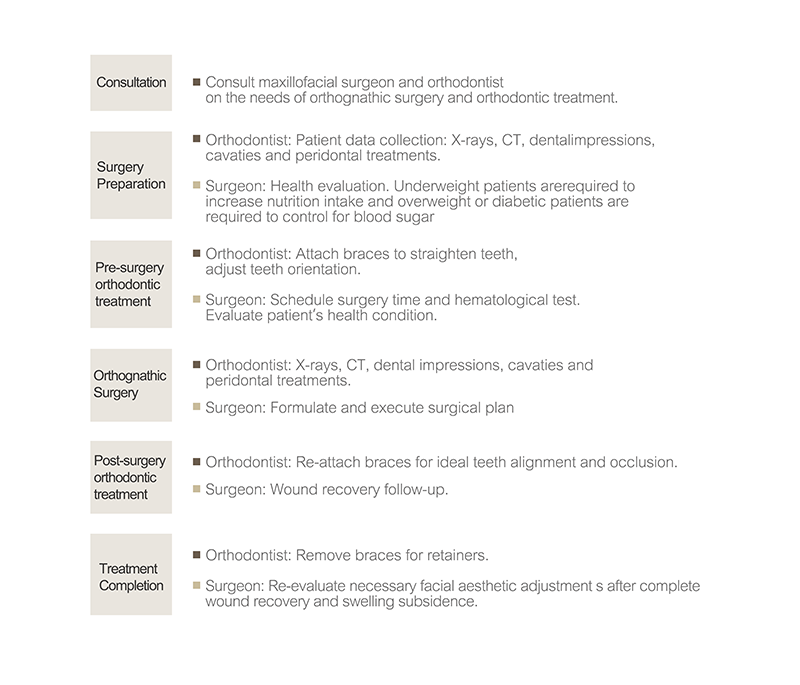
Before and After
Post Orthognathic Surgery Psychological Well-Being
Orthognathic surgery significantly affects the psychological well-being of patients as the procedure often “alters the human face fundamentally”. Although surgery outcome are positive in majority of cases, some patients may experience social identity issues caused by ruthless negative comments from their surroundings. Moreover, researchers have found such issues increased with patients’ age especially in those above 30 years old and some may take more than six months to adjust. Therefore, a thorough consultation with your surgeon is necessary before the surgery.
On the other hand, it is noteworthy that facial sagging may occur in some patients after the surgery due to the removal or reduction of bones. In that case, further cosmetic procedure may be recommended.
Frequently Asked Questions for Orthognathic Surgery
Q:Is orthodontic treatment required for orthognathic surgery ? Surgery first or Braces first ? Click for Answer
In conventional orthognathic surgery, patients are required to wear braces for 2-12 months in prior to the surgery. During the orthodontic treatment, patients may experience temporary masticatory discomfort and worsening of facial appearance. After the surgery, patients are required to wear braces for additional 3-6 months with the entire treatment lasting for 1.5-5 years.
To date, 70-80 % of Dr. Chen’s patients undergo the “Surgery First” approach, receiving orthognathic surgery before orthodontic treatment. Patients do not only appreciate the “Surgery First” approach for the instant improvement of facial appearance, but also prefer the exemption of the inconvenience and discomfort of pre-surgical orthodontic preparation.
Moreover, patients are only required to undergo 6-12 months of orthodontic treatments to align the teeth before completing the treatment. Cutbacks of treatment time are especially beneficial for overseas patients traveling to Taiwan for surgery. However, Dr. Chen would like to emphasize that the “Surgery First” approach may not suitable for all patients and he will generate the most ideal treatment plan during the consultation.
Q:Why is orthodontic treatment or osteotomy ineffective for protruding chin(Lantern Jaw)correction ? Click for Answer
Orthognatic surgery for protruding chin correction is divided into two parts: 1. reduce the length of protruding chin. 2. undergo orthodontic treatment to align the teeth to the new position of the jaw. Both parts are required to correct the condition of a protruding chin.
Q:Can rhinoplasty and cheek augmentation be done during the orthognathic surgery? Click for Answer
Orthognathic surgery is the most effective procedure for lower facial contouring generating the most natural outcome. Some patients may request other plastic surgery such rhinoplasty, cheek augmentation to be done in combination of orthognathic surgery. However, Dr. Chen usually suggests patients to put additional procedures on hold until 6 months after orthognathic surgery, because the improvement of facial profile often exceeds the patients’ expectations as orthognathic surgery greatly harmonizes facial features. Moreover, Dr. Chen is also more than willing to discuss options for additional surgeries based on patients’ needs.


